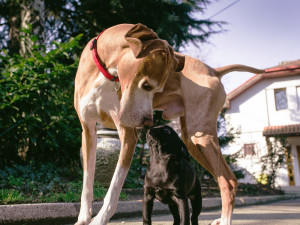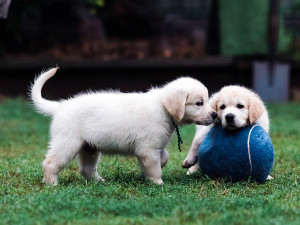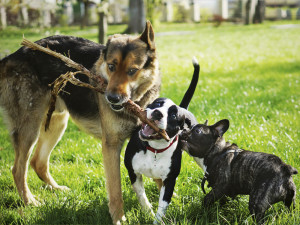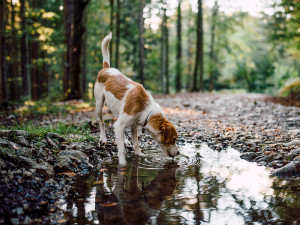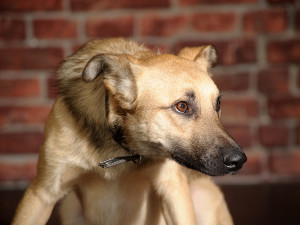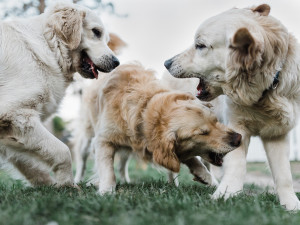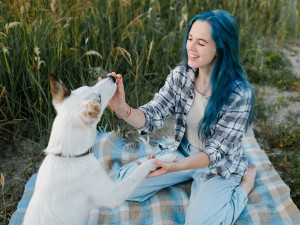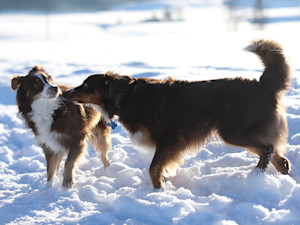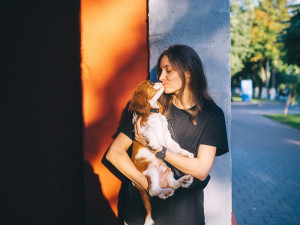Dog Park Etiquette: Dog Park Dos and Don’ts
New kid on the block? Follow this trainer’s tips before letting your pet run wild.
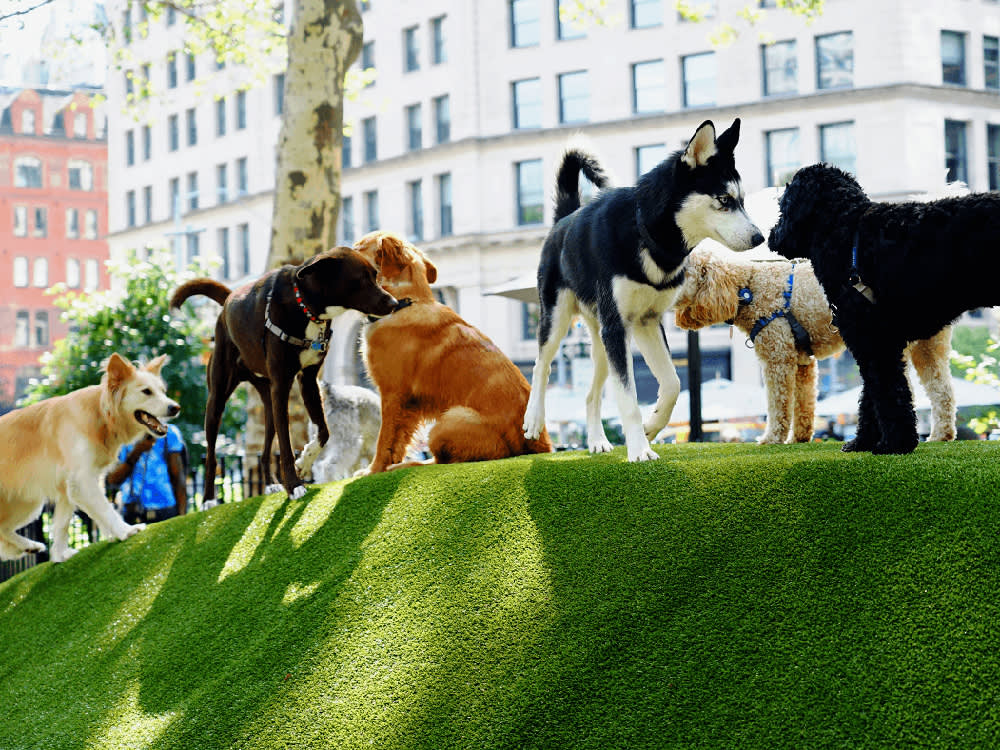
share article
“Wanna go to the park?!”
If those are your dog’s favorite words, this article is for you. If you’re about to become a dog parent for the first time and are about to start saying that phrase a lot, this article is also for you. The park can be a fun way for your pup to socialize and get some exercise — as long as you follow some basic dog park rules. We asked Robert Haussmann, certified dog trainer and co-founder of Dogboy NYCopens in a new tab, for tips on how you and your pup can be the cool kids at the park and not that dog and that human.
What is dog park etiquette, and why is it important?
Dog park etiquette is essential for you and your pup to have a positive experience —Haussmann shared his top tips for ensuring that you’re both following the rules and respecting the other humans and dogs there.
How do dog parks work?
Dog parks are generally areas that have been designated for dogs to play off leash. Each dog park has its own rules and regulations that are important to follow. Often, the area is fenced in, so it’s safe to let your dog run free and play. Sometimes, there are dog park activities your pup can partake in. You can even create your own dog parkopens in a new tab in some cases.
How can I tell if my dog is ready for the dog park?
If you’re wondering how to introduce your dog to the dog park: The best way to ensure that your dog has a good time is to not to go...until you’re ready. Dog parks can be good for socialization, but there are a few things you should know and do before your pup makes their dog park debut.
Know your dog.
Does your dog like to chase but not wrestle? Wrestle but not chase? Casually sniff things while never getting too close to another living thing? Understanding your dog’s likes and dislikes will help you determine if the dog park is something they are likely to enjoy, plus make it easier to assess if your dog is having a good time once they’re there.
Understand dog body language.
Dogs tell us a lot through their body language — if we know what to look for. “Sometimes, the signs they give are obvious (growling, snapping, raising their hacklesopens in a new tab). Other times, they’re more subtle (lip licking, yawning, avoiding eye contact),” Haussmann says. “It’s important to understand what the different visual cues mean so you know if your dog is feeling defensive, overwhelmed, nervous, etc.”
Have a grip on basic obedience.
The dog park is not the place to learn dog obedienceopens in a new tab. They should already reliably come when called and respond to commands like “drop it.” Says Haussmann: “If your dog doesn’t come unless you pull a piece of baconopens in a new tab out of your pocket that sends all the other dogs into a frenzy, that could be challenging for everyone involved.”
Ease into socialization.
Your dog’s first experience with other dogs shouldn’t be at a crowded dog park. It’s best to ease them into social situations — especially when they’re puppies. Haussmann recommends one-on-one playdates and puppy socialization classesopens in a new tab so puppies can learn how to interact before taking them to a park with adult dogs.
What should I do if my dog is exhibiting aggressive behavior?
It can be alarming if your dog is acting aggressive at the dog park, or is acting too rough. The main reasons why dogs become aggressive at the park are dominance and prey aggression, both of which can get out of hand (or paw) fast. So it’s important that you know what to do if this occurs: Keep a watchful eye on your dog because usually they will warn another dog with a growl or snap before they become physically aggressive.
Also, look out for aggressive physical cues such as standing very straight or direct eye contact. If you hear or notice any of these signs, put a leash on your dog and walk them out of the park. If your dog does get into a fight, remain calm while you try to break it up, keeping your own safety in mind because dog fights can be dangerousopens in a new tab.
Feeling good about all of the above? Before hitting up the park, read on for some dog park dos and don’ts.
Dog Park Dos
1. Do time your visits.
If your dog is new to the dog park or tends to get overwhelmed, 10 a.m. on Saturday when the park is packed probably isn’t the best time to go. Opt for off-peak times when the vibe is likely to be more low-key.
2. Do burn some energy before you arrive.
“If you have a dog who’s high energy, you may want to take them for a walkopens in a new tab before going into the park,” Haussmann says. “That will tire them out a little, so they’re not too over-zealous when they get around the other dogs.”
3. Do keep a close eye on your dog.
Not helicopter-parent close. But close. “Dogs need to learn how to read signs and resolve conflict non-violently on their own,” Haussmann says. “You don’t need to rush in and insert yourself into every situation. But if your dog is clearly bothering other dogs (bullying a young pup, not giving a dog space to get away) your dog may need to come out of the park for a while.”
4. Do check in with other pet parents.
If you’re not sure if your dog’s style of play is working for another dog, ask the pet parent. If they feel uncomfortable, consider removing your dog so the other pup gets a break. “Dog parks are a community,” Haussman says. “We all need to work together to keep everyone happy and healthy.”
5. Do act as a social coordinator.
Dogs need their crew. If your pup is playing well with a group of dogs, find their pet parents and see if you can coordinate days and times to come to the park together.
6. Do clean up after your dog.
Picking up poop sucks. Being judged for not picking up poop sucks more. Some parks will have poop bag dispensers on site but be sure you bring your own too, just in case.
7. Do bring water.
There will likely be a water source at the park. Still, to avoid any potentially contagious diseases, it’s best to have your own water bowl at the ready.
Dog Park Don’ts
1. Don’t bring treats or toys
But aren’t treats and toys the best? They are! Just not always at the park. “Dogs can be competitive around food and toys,” Haussmann cautions. “And some dogs can become reactive or aggressive, especially in high-arousal situations when they’re jazzed from playing. Younger dogs, in particular, can struggle when an element of competition gets introduced into the area.”
2. Don’t multitask.
Remember, you’re at the park to spend time with your dog. It’s not the place to catch up on emails or scroll through your social feed. Your dog is counting on you to help them stay safe and have fun.
3. Don’t bring your dog if they’re sick.
Your dog should have their vaccinations before heading to the park, but you should also be on the lookout for signs that your pup might not be feeling well. A touch of diarrhea, an isolated bout of vomitingopens in a new tab, or a minor cough may not be anything serious or contagious, but better safe than sorry.
4. Don’t pick your dog up.
Think there’s no harm in scooping your dog up when it’s time to take a break? Think again. “Dogs can get freaked out when they see another dog get picked up,” Haussmann says. “They may respond by jumping up or nipping at your dog, and your dog could end up getting hurt.”
5. Don’t go if it’s too hot. Or too cold.
Not every day is a good day to go to the park. If it’s a sizzling day, your pup could be at risk for heat exhaustionopens in a new tab or paw injuries from hot surfaces. Freezing days could be uncomfortable or even dangerous for your dog if they’re outside for too long.
If you only remember one thing, Haussman says, “Advocate for your dog. That’s one of your most important jobs as a pet parent.” Trips to the park are meant to be fun adventures for your pup. It’s okay to tell people what your dog does or doesn’t like. And if for some reason the dog park just isn’t your dog’s thing, that’s okay too — there are plenty of other ways you can exercise and socialize your dog.
FAQs (People Also Ask):
1) Can I bring a puppy to the dog park?
Once they have had all their shots, yes — but you don’t want your dog’s first socialization experience to be a busy dog park, so ease them in with other social situations first.
2) Should I bring my dog to the park if they are not well-socialized?
It’s not a good idea to bring your dog to the park if they’re not socialized — try introducing them to other, more easily controllable social situations.
3) Should I keep my dog on a leash inside the dog park?
If it is an off-leash park — most are —then you shouldn’t keep your dog on a leash because it can stress out your dog if other dogs are off leash and moving freely.
4) How can I prevent my dog from being overwhelmed or frightened at the park?
One way to to keep your dog from getting overwhelmed or becoming frightened opens in a new tabis to make sure they have their own space when they first enter the dog park.
5) Is it acceptable to bring treats or toys to the dog park?
Dogs can become competitive around food and toys, or get aggressive if they’re brought into a dog park, so it’s best not to bring them.
6) How should I handle my dog’s waste at the park?
Always pick up opens in a new tabyour dog’s poop at the park! Most parks will have poop-bag dispensers to use, but bring your own just in case and dispose of it in a trash can.
7) What if my dog is being bullied or intimidated by another dog?
If you feel comfortable you could talk to the other dog’s owner to ask if they could intervene. If that’s not an option, remove your dog from the park.
References:
Animal Protective Foundation Dog Park Etiquette opens in a new tab
Everything You Need to Know About Dog Parks and Dog Agility Equipmentopens in a new tab
Animal Hospital West Lake Forest Aggressive Behavior Between Dogs at the Dog Parkopens in a new tab
Parnell Living Science Dog Park Etiquette Do's and Don't'sopens in a new tab

Kate Sheofsky
Kate Sheofsky hails from San Francisco, where she developed a love of writing, Giants baseball, and houses she can’t afford. She currently lives in Portland, OR, and works as a freelance writer and content strategist. When not typing away on her laptop, she enjoys tooling around the city with her two rescue pups searching for tasty food and sunny patios.
Related articles
![Three golden retriever's playing in the grass.]() opens in a new tab
opens in a new tabHow to Break Up a Dog Fight
Keep you and your dog safe in case of a dog fight emergency.
![girl with blue hair starting puppy training with white dog]() opens in a new tab
opens in a new tabPuppy Training 101: How to Train a Puppy
You gotta start somewhere.
![person playing tug with dog]() opens in a new tab
opens in a new tabThe Do’s and Don’ts of Playing with Your Dog
Chase? Wrestle? Tug-o-war? Find out which are fair game.
![Two Australian Shepherd dogs meeting in the snow]() opens in a new tab
opens in a new tabAre Your Dogs Arguing With Each Other?
How to tell the difference between dog aggression and communication.
![Woman holding a beagle in warm dappled summer light]() opens in a new tab
opens in a new tabYou’ve Got a Summer-Lovin’ Pup. Here’s How to Keep Them Safe
Some like it hot (but not most dogs). Here are the season’s health hazards, from fleas to foxtails.
